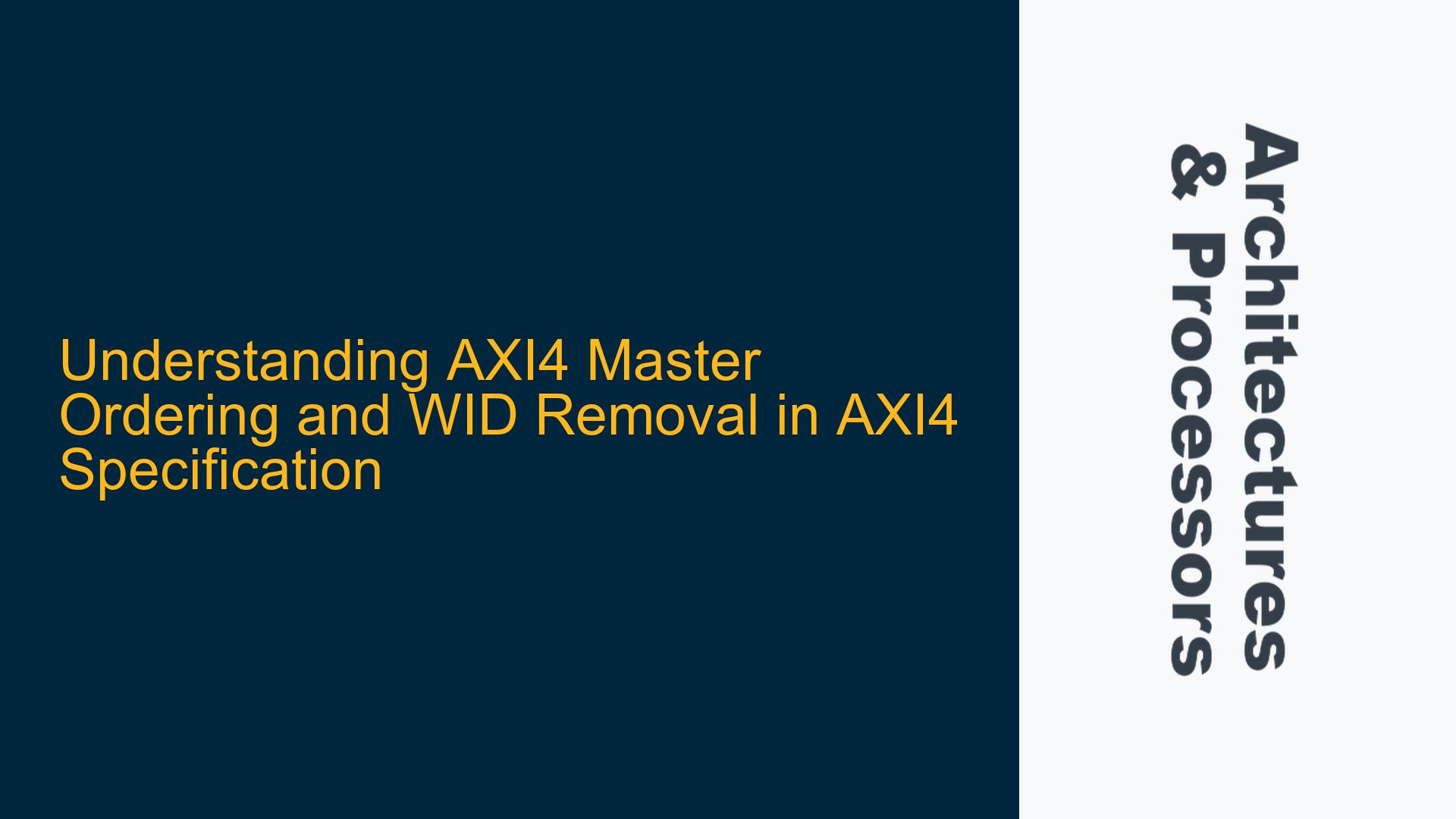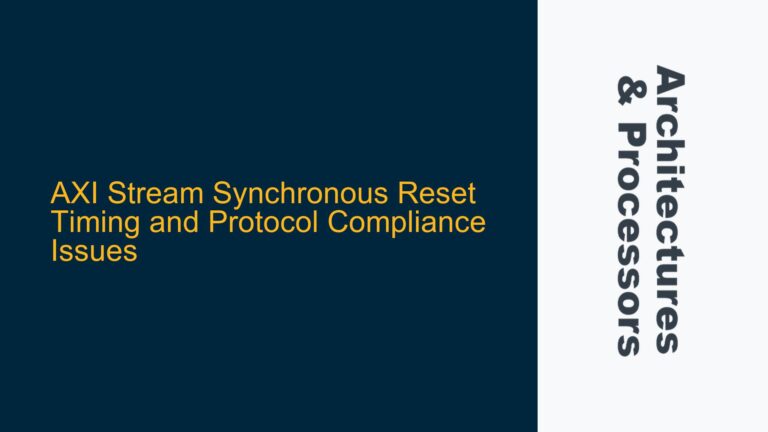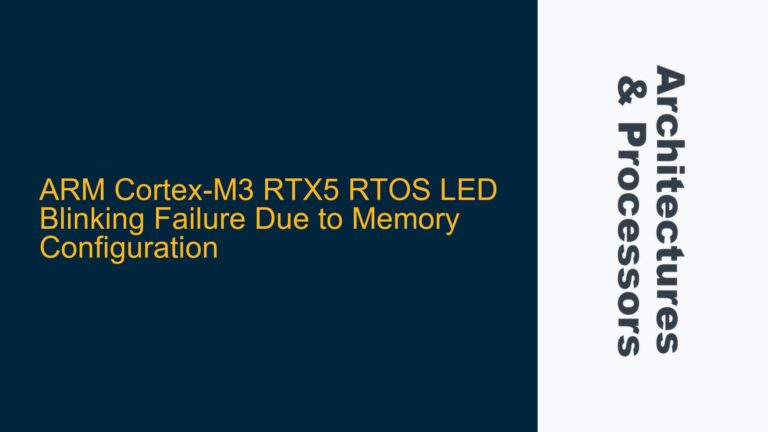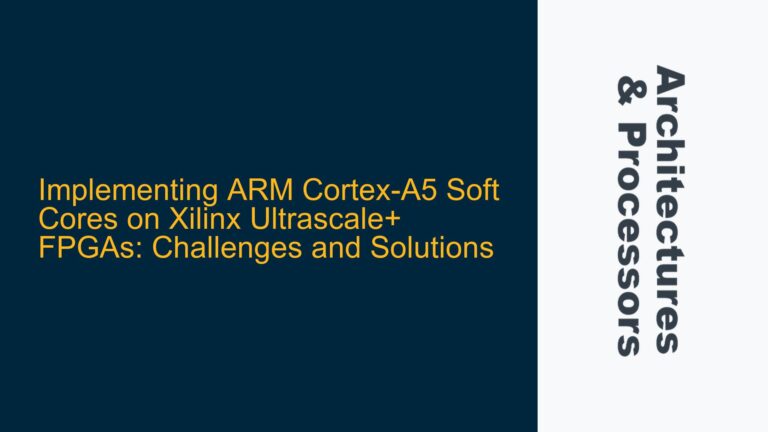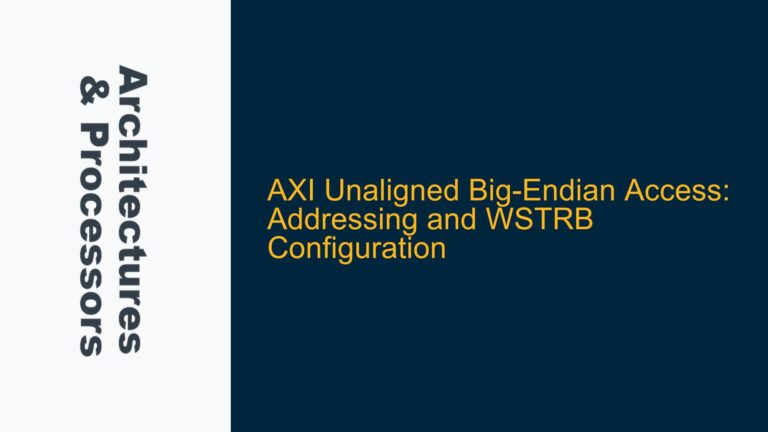AXI4 Master Ordering Model and WID Removal Confusion
The AXI4 protocol, an evolution of the AXI3 specification, introduces several changes to improve performance and simplify implementation. One of the most significant changes is the removal of the Write ID (WID) signal, which was present in AXI3. This removal has implications for the ordering model, particularly in the context of overlapping transactions and master ordering. The AXI4 specification, in Chapter A6: AXI Ordering Model, outlines the rules for transaction ordering, but the removal of WID has led to confusion, especially in understanding how overlapping transactions are handled without WID.
In AXI3, the WID signal was used to tag write transactions, allowing multiple write transactions to be issued out of order while maintaining the ability to track their completion. This was particularly useful in systems where multiple masters or threads were issuing write transactions concurrently. The WID signal ensured that the responses to these write transactions could be correctly matched to the original transactions, even if they completed out of order.
With the removal of WID in AXI4, the protocol relies on a different mechanism to handle overlapping transactions. The AXI4 specification introduces the concept of "ordering regions" and "transaction IDs" to manage the ordering of transactions. However, the exact mechanism by which overlapping transactions are handled without WID is not immediately clear, leading to confusion for those transitioning from AXI3 to AXI4.
The key to understanding the AXI4 ordering model lies in the way transaction IDs are used to group related transactions and how the protocol ensures that transactions within the same group are ordered correctly. The AXI4 specification defines a set of rules that govern how transactions are ordered, both within and across different transaction groups. These rules are designed to ensure that the system behaves predictably, even in the presence of overlapping transactions.
Implications of WID Removal on Overlapping Transactions
The removal of the WID signal in AXI4 has significant implications for how overlapping transactions are handled. In AXI3, the WID signal allowed multiple write transactions to be issued out of order, with the responses being matched to the original transactions using the WID. This mechanism ensured that the system could handle overlapping write transactions efficiently, even in complex multi-master systems.
In AXI4, without the WID signal, the protocol must rely on other mechanisms to ensure that overlapping transactions are handled correctly. The AXI4 specification introduces the concept of "transaction IDs" to group related transactions. Each transaction is assigned a unique ID, and transactions with the same ID are considered part of the same group. The protocol ensures that transactions within the same group are ordered correctly, even if they are issued out of order.
The AXI4 ordering model also introduces the concept of "ordering regions," which are used to define the scope within which transactions must be ordered. Transactions within the same ordering region must follow the ordering rules defined by the protocol, while transactions in different ordering regions can be handled independently. This allows the system to handle overlapping transactions more efficiently, as transactions in different regions can be processed in parallel without affecting each other.
However, the removal of WID also means that the system must rely on other mechanisms to ensure that write transactions are completed in the correct order. In AXI4, the protocol uses the "write data interleaving" mechanism to handle overlapping write transactions. This mechanism allows the system to interleave write data from different transactions, as long as the transactions are part of the same group and follow the ordering rules defined by the protocol.
The AXI4 specification also introduces the concept of "write data buffering," which allows the system to buffer write data and ensure that it is written to memory in the correct order. This mechanism is particularly important in systems where multiple masters are issuing write transactions concurrently, as it ensures that the data is written to memory in the correct order, even if the transactions are issued out of order.
Implementing AXI4 Ordering Rules and Handling Overlapping Transactions
To implement the AXI4 ordering rules and handle overlapping transactions correctly, it is essential to understand the role of transaction IDs and ordering regions in the AXI4 protocol. The transaction ID is used to group related transactions, and the protocol ensures that transactions within the same group are ordered correctly. The ordering region defines the scope within which transactions must be ordered, and transactions in different regions can be handled independently.
When implementing the AXI4 ordering rules, it is important to ensure that the system correctly assigns transaction IDs to each transaction and that the transactions within the same group follow the ordering rules defined by the protocol. This requires careful management of the transaction IDs and the ordering regions, as well as the use of appropriate mechanisms to handle overlapping transactions.
One of the key mechanisms for handling overlapping transactions in AXI4 is the write data interleaving mechanism. This mechanism allows the system to interleave write data from different transactions, as long as the transactions are part of the same group and follow the ordering rules defined by the protocol. The write data interleaving mechanism is particularly important in systems where multiple masters are issuing write transactions concurrently, as it allows the system to handle overlapping write transactions efficiently.
Another important mechanism for handling overlapping transactions in AXI4 is the write data buffering mechanism. This mechanism allows the system to buffer write data and ensure that it is written to memory in the correct order. The write data buffering mechanism is particularly important in systems where multiple masters are issuing write transactions concurrently, as it ensures that the data is written to memory in the correct order, even if the transactions are issued out of order.
In addition to the write data interleaving and buffering mechanisms, the AXI4 protocol also relies on the use of transaction IDs and ordering regions to ensure that transactions are ordered correctly. The transaction ID is used to group related transactions, and the protocol ensures that transactions within the same group are ordered correctly. The ordering region defines the scope within which transactions must be ordered, and transactions in different regions can be handled independently.
To implement the AXI4 ordering rules and handle overlapping transactions correctly, it is essential to carefully manage the transaction IDs and the ordering regions, as well as the use of appropriate mechanisms to handle overlapping transactions. This requires a deep understanding of the AXI4 protocol and the mechanisms it uses to ensure that transactions are ordered correctly.
In conclusion, the removal of the WID signal in AXI4 has significant implications for how overlapping transactions are handled. The AXI4 protocol introduces the concept of transaction IDs and ordering regions to manage the ordering of transactions, and relies on mechanisms such as write data interleaving and buffering to handle overlapping transactions efficiently. To implement the AXI4 ordering rules and handle overlapping transactions correctly, it is essential to understand the role of transaction IDs and ordering regions in the AXI4 protocol, and to use appropriate mechanisms to ensure that transactions are ordered correctly.
